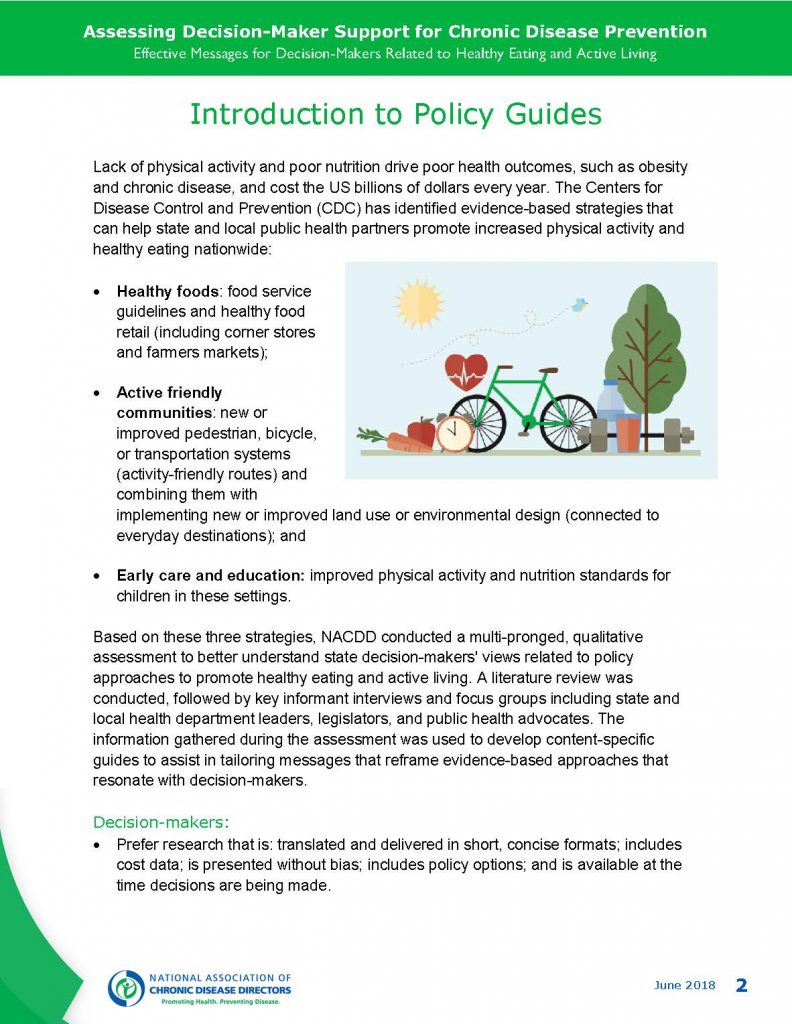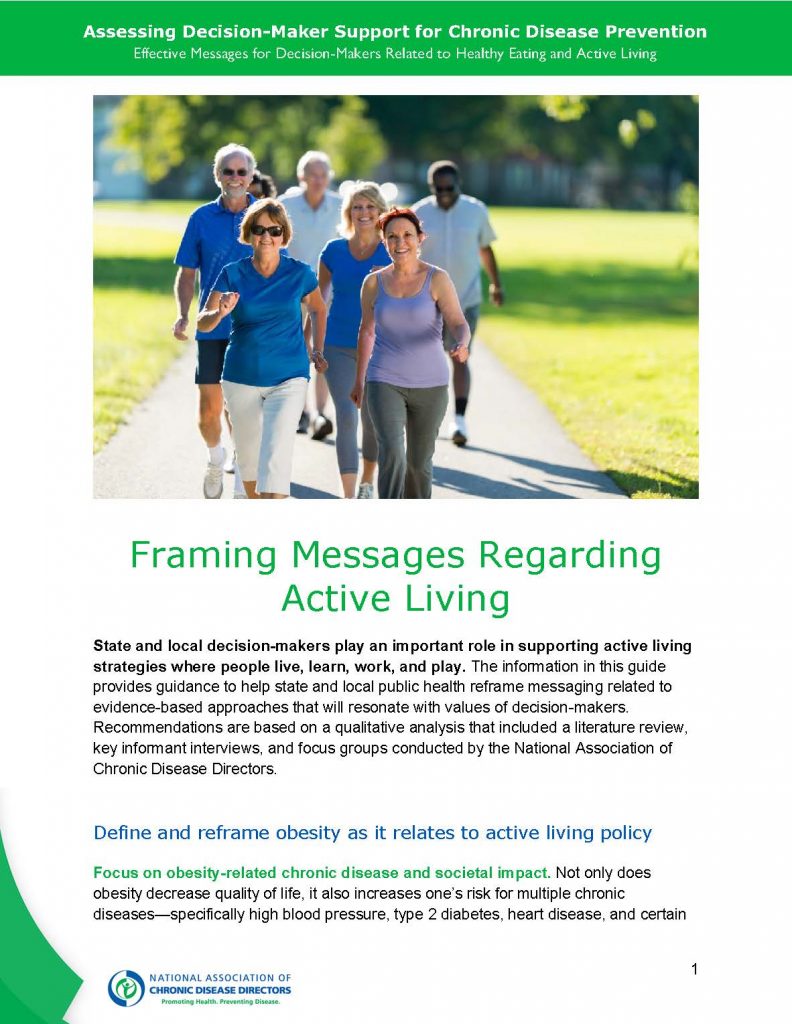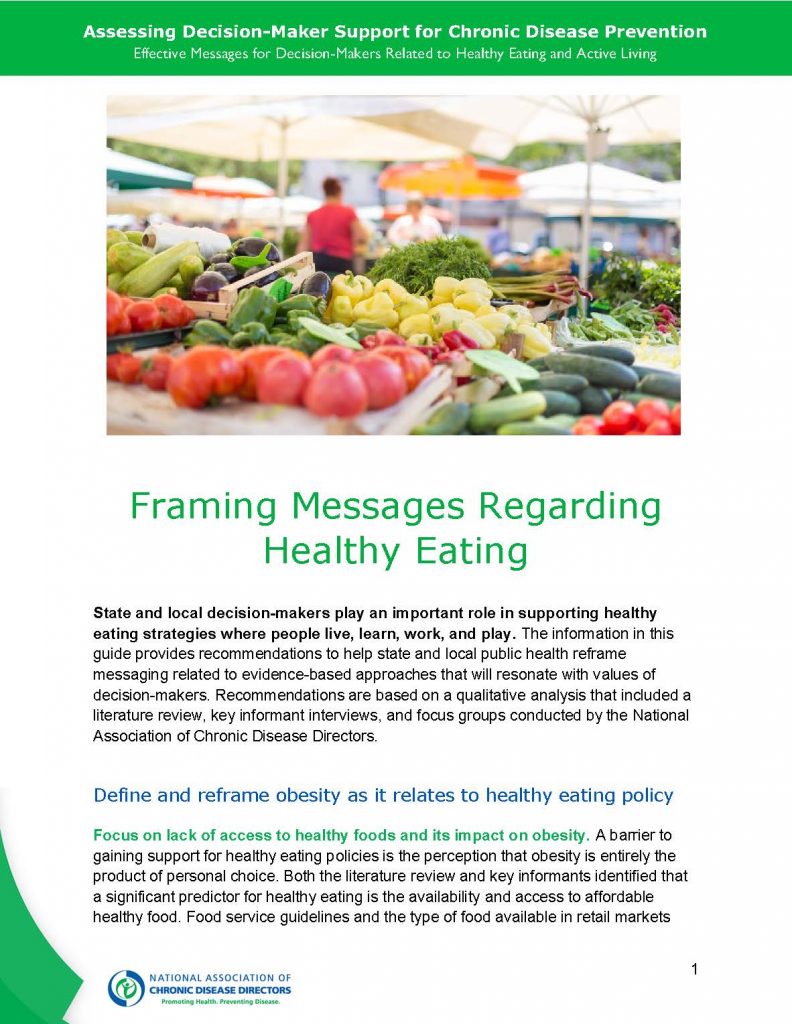Lack of physical activity and poor nutrition drive poor health outcomes, such as obesity and chronic disease, and cost the US billions of dollars every year. The Centers for Disease Control and Prevention (CDC) has identified evidence-based strategies that can help state and local public health partners promote increased physical activity and healthy eating nationwide. Based on these strategies, NACDD conducted a multi-pronged, qualitative assessment to better understand state decision-makers’ views related to policy approaches to promote healthy eating and active living. A literature review was conducted, followed by key informant interviews and focus groups including state and local health department leaders, legislators, and public health advocates. The information gathered during the assessment was used to develop content-specific guides to assist in tailoring messages that reframe evidence-based approaches that resonate with decision-makers.
ASSESSING DECISION-MAKER SUPPORT FOR CHRONIC DISEASE PREVENTION
Effective Messages for Decision-Makers Related to Healthy Eating and Active Living
Introduction to Policy Guides
Lack of physical activity and poor nutrition drive poor health outcomes, such as obesity and chronic disease, and cost the US billions of dollars every year. The Centers for Disease Control and Prevention (CDC) has identified evidence-based strategies that can help state and local public health partners promote increased physical activity and healthy eating nationwide:
• Healthy foods: food service guidelines and healthy food retail (including corner stores and farmers markets);
• Active friendly communities: new or improved pedestrian, bicycle, or transportation systems (activity-friendly routes) and combining them with
implementing new or improved land use or environmental design (connected to everyday destinations); and
• Early care and education: improved physical activity and nutrition standards for children in these settings.
Based on these three strategies, NACDD conducted a multi-pronged, qualitative assessment to better understand state decision-makers’ views related to policy approaches to promote healthy eating and active living. A literature review was conducted, followed by key informant interviews and focus groups including state and local health department leaders, legislators, and public health advocates. The information gathered during the assessment was used to develop content-specific guides to assist in tailoring messages that reframe evidence-based approaches that resonate with decision-makers.
Decision-makers:
- Prefer research that is: translated and delivered in short, concise formats; includes cost data; is presented without bias; includes policy options; and is available at the time decisions are being made.
- Support obesity reduction policies that involve public schools and community-based interventions; policies with positive implications for government finance; and policies utilizing partnerships with community stakeholders.
- Look to voices from the business community, medical society, local voting boards, grass roots organizations, and advocates for determining policy priorities. Credibility and knowledge of the presenter was important.
- Want information on the potential impact of a proposed policy on business interests and values related to local government control and decision making. They expect measurable, immediate, and substantial returns on their investments.
When tailoring materials to state-level decision-makers, state and local public health can:
- Define and reframe obesity, using consistent messages.
- Communicate the economic perspective to move healthy eating and active living strategies forward.
- Focus on local data and solutions, rather than national statistics or problems.
- Discuss impact on specific populations of highest interest such as children, youth, and older adults.
Key informants and focus group participants emphasized the critical role fulfilled by the State Health Departments as:
- A convener and collaborative partner;
- A voice for supporting evidence based healthy eating and active living policy; and
- A source of expertise for implementing healthy eating and activity living strategies.
- State Health Departments frequently are called upon to assist with convening partners at the local level, providing subject matter expertise and technical assistance to guide local agencies in initiating and implementing healthy eating and active living strategies.
- Partnerships with State Health Departments were perceived to be important to promote policy at the local level and inform policy at the state level through provision of data and best practices and technical assistance to build capacity.
This publication was supported by the Cooperative Agreement Number 5U38OT000225-05, funded by the Centers for Disease Control and Prevention. Its contents are solely the responsibility of the authors and do not necessarily represent the official views of the Centers for Disease Control and Prevention or the Department of Health and Human Services.
For more information on this publication, please contact Julia Schneider at jschneider@chronicdisease.org, or Paula Clayton at pclayton@chronicdisease.org.



